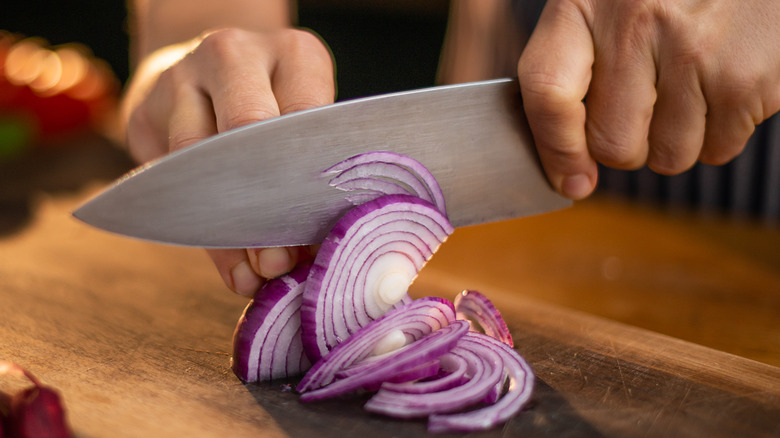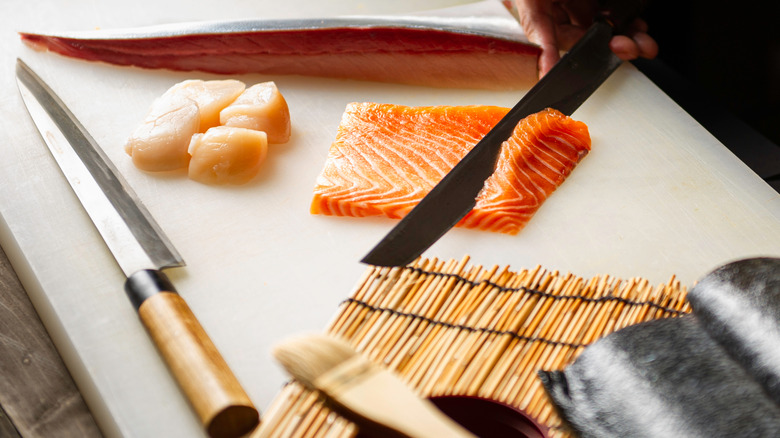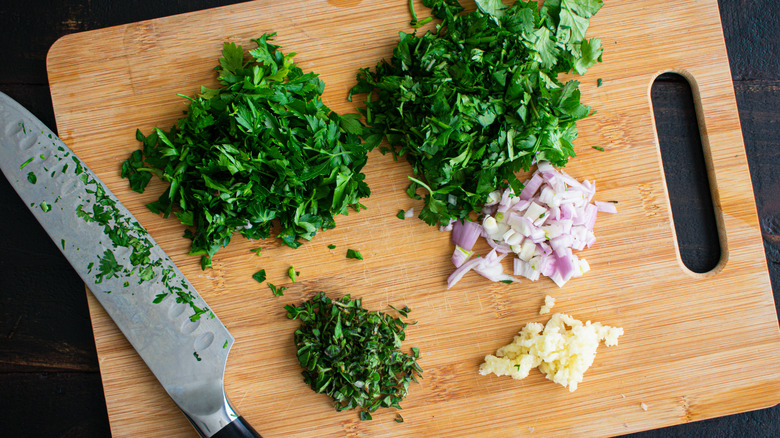Here's What Separates Japanese And Western Knives
A good kitchen knife is an excellent investment for both professional and home cooks. Everyone has a different set of needs out of their kitchen knife; a knife that is perfect for a sushi chef working at a restaurant that does 400 covers per night will definitely not be the ideal knife for a college student learning to cook for the first time.
When shopping for a knife, it's essential to take your needs into consideration, as well as the upkeep and maintenance. While a professional cook may be fine purchasing a knife that needs to be honed with every use and sharpened on a whetstone once a week, a home cook will probably want something more low-maintenance. If you're someone that cooks often, you might be in the market for something more versatile or durable than someone who only cooks casually.
One of the first things you'll need to decide when starting the process of buying a new knife: Japanese-style or Western-style? There are a few key differences between these two knife styles, and once you know which is which, it's easy to pick a knife that will suit your needs best based on their characteristics.
The blade angle is a major difference
Most chef's knives fall into one of two categories. Many of the knives on the market that you might be familiar with are Western-style knives, but Japanese knives are also popular.
The most significant difference between Japanese and Western-style knives is the angle of the blade. The angle of the blade on a Western-style knife is beveled on both sides, meaning "the blade is sharpened symmetrically on both sides," as Serious Eats explains. This means you can use the knife in either hand because the angle of the edge is the same on both sides. In contrast, Japanese-style knives are often single bevel knives, meaning the blade is only sharpened on one side, or sometimes sharpened to a more aggressive angle on one side.
Whereas a Western-style knife has a 50/50 grind giving the blade that symmetry, Japanese-style knives may have a 100/0 — or sometimes, up to an 80/20 — ratio (via Knives From Japan). A Japanese-style blade is excellent for things like cutting thin slices of fish for sushi because of its aggressive angle, while an equal-edged Western-style is great for more perpendicular tasks like chopping vegetables.
Blade shape and hardness are also defining differences
The shape and hardness of the blade can also differentiate Japanese-style from Western-style knives. While there is a lot of variation from brand to brand, most follow these rules in terms of shape. Generally, Japanese knives "have straight blades which are thinner and thus, sharper, making them ideal for precision cuts like slicing, fine mincing, julienne, trimming, and cutting softer foods" (via CNet). In contrast, a Western-Style knife is "curved, which facilitates the rocking style of chopping," according to The Kitchn.
Because of their shape and blade angle, Japanese knives are made of harder steel than Western-style knives, which are 60 to 63 on the Rockwell hardness scale, whereas a Western-style is usually around 57 (via Tasting Table). The hardness of a Japanese-style knife allows it to hold an edge for longer and requires less frequent sharpening. In contrast, a Western-style knife's softer steel means it needs to be sharpened more often. However, that softer steel can actually be a benefit, because that means it is a lot easier to sharpen.
Both types of knives have their strengths and weaknesses, so your needs and preferences on big things like blade angle or littler things like handle shape are what determine which style will suit you best.


